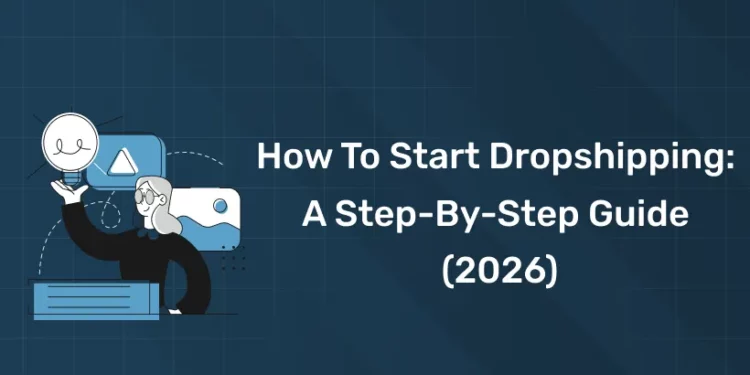Table of Contents
If you’ve been scrolling through e-commerce content on Instagram or YouTube, you’ve definitely heard this pitch:
“Start an online store with no stock, no warehouse, and very little investment.”
That’s dropshipping in one line.
In simple terms, dropshipping is an online business model where you sell products through your own website or marketplace store, but your supplier stores, packs, and ships the order directly to your customer. You handle the marketing and customer relationship; the supplier handles inventory and logistics.
For normal users who want a side income and aspiring/working digital marketers who want to practice real performance marketing with low risk, dropshipping is a great playground if you do it professionally.
Join Our Online Digital Marketing Course & Learn the Fundamentals!
What Is Dropshipping and How Does It Work?
Let’s get the basics crystal clear.
1. The dropshipping model in plain English
In a traditional e-commerce model:
- You buy inventory in bulk
- Store it in your warehouse
- Pack and ship each order yourself (or via a 3PL)
In dropshipping:
- Customer places an order on your website (₹999 T-shirt, for example)
- You forward order details to your supplier or your system does it automatically
- Supplier packs and ships the product directly to your customer
- You keep the margin between what the customer paid and what you pay the supplier
You focus on:
- Choosing the right products
- Building a trustworthy store
- Running performance marketing campaigns
- Handling customer service and brand building
The supplier focuses on:
- Inventory
- Packing
- Shipping
2. Pros and cons
Advantages
- Low initial investment (no stock to buy upfront)
- Easy to test multiple products and niches
- Location-independent (you can operate from anywhere)
- Great sandbox for digital marketing experiments
Challenges
- Lower margins compared to buying in bulk
- You don’t control shipping speed or packaging quality
- Customer is your responsibility even if supplier messes up
- Competition can be high in generic niches
Dropshipping is not a get-rich-quick hack. It’s a real business with real customers, just without physical inventory.
Is Dropshipping Legal?
1: What is the primary goal of SEO (Search Engine Optimization)?
Short answer: Yes, dropshipping is legal in India and most countries, as long as you follow the relevant tax, import, and consumer protection laws.
For India specifically, multiple recent guides point out:
- Dropshipping is treated like any other online trading business
- GST registration becomes mandatory once you cross certain turnover thresholds (generally ₹20 lakh per year; lower in some special-category states)
- Some marketplaces or payment gateways may require GST even earlier, especially if you sell inter-state or via platforms like Amazon, Flipkart, Shopify, etc.
Important disclaimer:
This article is not legal or tax advice. Always check with a CA or legal professional in your region before launching.
Key legal/operational points to keep in mind:
- Register your business (sole proprietorship/LLP/company based on your CA’s advice)
- Understand GST, invoicing, and return filing if you’re in India
- Don’t sell restricted products or items that need special certifications (e.g., electronics needing BIS approval in India).
- Follow consumer protection rules – clear policies, honest product pages, proper returns/refund handling
Become an AI-powered Digital Marketing Expert
Master AI-Driven Digital Marketing: Learn Core Skills and Tools to Lead the Industry!
Explore CourseStep 1: Choose Your Dropshipping Niche
Random product = random results.
A niche is the focused category or problem area you serve. For example:
- Home & kitchen organisation
- Minimalist desk setups
- Pet accessories for cats
- Baby & toddler learning toys
- Fitness accessories for office workers
1. How to choose a good niche
Ask yourself:
- Who am I selling to?
- Students, parents, working professionals, fitness lovers, gamers, etc.
- What problem or desire am I solving?
- Better sleep, more comfort, saving time, feeling stylish, productivity, etc.
- Is there real demand?
- Search volume on Google for related terms
- Products trending on marketplaces
- Social media interest (Reels, YouTube, TikTok-like platforms)
- Is the niche allowed and practical?
- Avoid restricted, dangerous, or heavily regulated products
- Avoid extremely fragile items unless your supplier is excellent
- Can I market this niche creatively?
- As a digital marketer, pick niches where you can create content, hooks, and ads easily.
Good dropshipping niches usually:
- Allow good margins (you can at least 2x your cost price)
- Are not too dominated by big brands
- Have multiple product ideas, not just one or two
Step 2: Do Product Research (Before You Build Anything)
Don’t build a store and then wonder what to sell. Product research comes first.
Product research is the process of evaluating whether a product idea can succeed in the market by analysing demand, trends and competition.
1. Where to look for product ideas
- Marketplaces: Amazon Best Sellers, Flipkart, Meesho, Etsy (for global), etc.
- Social media: Look at viral products in Reels/Shorts, influencer posts, #unboxing etc.
- Product research tools: There are many tools (free/paid) that show trending items, ad creatives, store examples.
- Competitors: Check what successful dropshipping stores are selling, how they price, and how they position.
2. What makes a “good” dropshipping product?
Common qualities of winning products:
- Solves a clear problem or creates a “wow, I need this” reaction
- Not too heavy or bulky (to keep shipping feasible)
- Reasonable price range (often impulse-buy friendly)
- Has clear visual benefits (easy to show in a 10–20 second ad)
- Not something that is obviously available cheaper everywhere offline
3. Quick sanity checks
For each shortlisted product:
- Are there enough people searching for it or related terms? (Check Google Trends, keyword tools)
- Are there reviews and proof that it sells in other stores/marketplaces?
- Do you have multiple supplier options?
- Can you create multiple ad angles for it?
Only move ahead with products that pass both demand and supply checks.
5. Step 3: Decide Where You Will Sell
Broadly, you have three options:
- Your own online store (Shopify, WooCommerce, Wix, etc.)
- Marketplaces (Amazon, Flipkart, Meesho, etc.)
- Hybrid (own store + marketplace presence)
1. Your own store
Platforms like Shopify, WooCommerce, Wix, BigCommerce, Squarespace are widely used across the world for dropshipping and general e-commerce.
Pros:
- You control the brand, design, and user journey
- Easier to implement advanced performance marketing (Meta ads, Google Ads, remarketing, tracking etc.)
- You own your first-party data (emails, phone numbers)
Cons:
- You must drive traffic (no built-in marketplace traffic)
- You handle everything – traffic, conversion, trust building
2. Marketplaces
Pros:
- Built-in traffic – users already searching there
- Easier “plug and play” listing
Cons:
- Lower control over branding
- Higher competition & commission
- Some restrictions on pure dropshipping depending on the platform’s policy
For many aspiring digital marketers, starting with your own store makes more sense because it forces you to learn:
- Landing page structure
- Conversion rate optimisation
- Tracking and analytics
- Full-funnel marketing
Become an AI-powered Digital Marketing Expert
Master AI-Driven Digital Marketing: Learn Core Skills and Tools to Lead the Industry!
Explore CourseStep 4: Choose Your E-commerce Platform & Tech Stack
Your platform should match:
- Your budget
- Your technical comfort
- The level of customisation you want
Common options:
- Shopify – All-rounder SaaS platform with tons of apps, now even adding AI store-building features to speed up setup.
- WooCommerce (WordPress) – Highly customisable, good for those comfortable with WordPress, widely used globally.
- Wix / Squarespace – Easier for beginners, especially for smaller catalogues.
Whatever you pick, make sure it supports:
- Integration with dropshipping apps or supplier APIs
- Payment gateways suitable for your target geography (UPI, cards, wallets, PayPal, etc.)
- Mobile-friendly templates
- Basic SEO settings (title tags, meta descriptions, clean URLs)
Step 5: Find and Vet Suppliers
Your supplier can make or break your dropshipping business.
1. Types of suppliers
- Global marketplaces (AliExpress, etc.) – huge variety but often longer shipping times
- Print-on-demand services – for T-shirts, mugs, phone cases
- Local / India-based suppliers – faster shipping within India, often better for COD and returns
- Dedicated dropshipping platforms – that connect multiple brands and suppliers into one dashboard
2. How to evaluate a supplier
Look for:
- Shipping times to your target regions (be transparent on your website)
- Product quality – always order samples before going big
- Consistency – stock availability, communication speed
- Return / refund handling
- Ability to blind ship (no random logos or invoices in the parcel)
Red flags:
- Very poor reviews
- Lack of clear policies
- Takes days to reply to basic questions
Dropshipping margins are often thin; repeated returns and angry customers will wipe them out quickly.
Step 6: Set Up Your Store for Trust & Conversions
This is where your marketing brain kicks in.
1. Essentials your store must have
- Clear niche and brand identity – colours, logo, tagline
- High-quality product images and short product videos
- Benefit-driven descriptions – not just features, but “what it does for the customer”
- Transparent policies – shipping timelines, returns, refunds, contact information
- Social proof – reviews, ratings, UGC (only use authentic content)
2. Pricing and margins
Set a selling price that covers:
- Product cost
- Shipping (if you are absorbing some cost)
- Marketing cost (your ad spend per sale
- Platform fees and payment gateway charges
- Taxes
- Your profit margin
Many dropshippers start by aiming for at least a 2–3x markup on product cost, then adjust based on performance.
3. AEO-friendly and SEO-friendly content
For Answer Engine Optimisation (AEO) and SEO:
- Use question-style headings on product and blog pages.
- Example: “How does this posture corrector work?”
- Add a short, direct answer immediately after each question.
- Include FAQs at the bottom of category and product pages.
- Optimise your titles and meta descriptions around search intent:
- “best [niche] product for [audience]”
- “how to use [product] for [benefit]”
This helps not just with classic SEO, but also with answer-style results in modern search and AI surfaces.
Step 7: Set Up Operations & Customer Support
Even without inventory, you still need strong operations.
1. Order flow
Define and document:
- What happens when an order comes in (who forwards to supplier, how, how quickly)
- How tracking IDs are captured and sent to customers
- How you update order statuses in your store / CRM
Use automation where possible (e.g., apps that auto-forward orders to suppliers), but keep manual checks early on.
2. Customer service
Decide:
- Support channels (email, WhatsApp, chat, phone)
- Response time target (e.g., within 24 hours)
- Standard reply templates for:
- “Where is my order?”
- “I want to change address”
- “I want a refund/return”
Good customer service can compensate for slightly longer dropshipping delivery times.
Join Our Online Digital Marketing Course & Learn the Fundamentals!
Step 8: Launch and Market Your Dropshipping Store
Here’s where digital marketers shine.
You can drive traffic from:
- Meta Ads (Facebook & Instagram) – ideal for visual products and impulse purchases
- Google Ads – great for capturing high-intent search traffic
- YouTube Ads – explainer videos, reviews, or UGC-style demonstrations
- Influencer & creator marketing – reels, shorts, review videos
- SEO & content marketing – blog posts, buying guides, product comparison pages
A simple launch plan
- Start with one or two flagship products, not 100.
- Create 3–5 ad creatives focusing on different hooks:
- Problem/solution
- Before/after
- Social proof
- Offer/urgency
- Run small-budget tests on Meta or Google to see which creative + audience combo works.
- Optimise:
- Pause under-performers
- Scale winners gradually
- Improve landing pages based on data
Step 9: Track Metrics and Scale Like a Pro
If you treat dropshipping as a learning lab for performance marketing, these metrics are your best friends:
- CTR (Click-Through Rate) – tells you if your creatives are resonating
- CPC (Cost Per Click) – how expensive your traffic is
- Conversion Rate – percentage of visitors who buy
- CPA / CPL (Cost Per Acquisition / Lead) – how much you spend per sale or lead
- ROAS (Return on Ad Spend) – revenue ÷ ad spend
- AOV (Average Order Value) – helps you plan upsells and bundles
Your goal:
- Either improve conversion rate / AOV
- Or lower CPC / CPA through better targeting, creative, and landing pages
Once you have 1–2 profitable products, you can:
- Add complementary products
- Test new audiences / countries
- Experiment with email marketing, loyalty programs, subscriptions
Common Mistakes New Dropshippers Make
Avoid these classic traps:
- Copy-paste stores – using the same theme, copy, and supplier images as everyone else.
- No niche – trying to sell random trending items with no brand story.
- Ignoring shipping timelines – not telling customers it may take 7–15 days; this kills trust.
- No clear policies – no return policy, no contact info, no address = zero trust.
- Blind scaling – increasing ad budgets without tracking true profitability.
- Zero reinvestment in brand – not improving creatives, packaging, or website even after early wins.
Dropshipping rewards those who treat it like a real brand, not a quick money trick.
Where Entri’s AI-Powered Digital Marketing Course Fits In
Everything you’ve read so far – niche selection, product research, platform choice, ad testing, creative angles, funnel optimisation – sits squarely inside the skill-set of a modern performance marketer.
That’s exactly where an AI-powered digital marketing course from Entri becomes valuable:
- You learn Meta Ads, Google Ads, YouTube Ads, SEO, and analytics in a structured way
- You understand how to build and optimise high-converting landing pages
- You see real-world case studies of e-commerce campaigns (not just theory)
- You learn how to use AI tools to:
- Research products and audiences
- Generate multiple ad variations quickly
- Analyse campaign data and generate insights
- You can apply everything you learn directly to your dropshipping store, freelance clients, or full-time job campaigns
Instead of randomly running ads and burning money, you approach dropshipping like a trained marketer, testing, optimising, and scaling in a disciplined way.
Key Takeaways: How to Start Dropshipping, Step-by-Step
- Yes, dropshipping is legal in India and many other countries if you follow tax, import and consumer laws.
- Start with a clear niche and audience, not random products.
- Do proper product research to validate demand and margins before building your store.
- Choose an e-commerce platform like Shopify, WooCommerce, or Wix based on your technical comfort and budget.
- Vet suppliers carefully for shipping times, quality, and communication. Order samples.
- Build your store for trust and conversions – strong product pages, clear policies, social proof.
- Use performance marketing (Meta, Google, YouTube) + content + SEO to drive traffic.
- Track key metrics (CTR, CPC, ROAS, conversion rate, AOV) and scale what works.
- Treat dropshipping as a real brand and a learning lab for your digital marketing career.
- Consider structured training like Entri’s AI-powered digital marketing course to shorten your learning curve and avoid expensive mistakes.
Conclusion
Starting a dropshipping business in 2026 is easier than ever, but succeeding requires clarity, consistency, and strong digital marketing skills. With the right niche, suppliers, store, and marketing strategy, you can build a profitable online business without holding any inventory. What separates successful dropshippers from the rest isn’t luck; it’s their ability to research trends, test products quickly, analyse data, and optimise campaigns every week.
If you treat dropshipping as a real business, follow the steps and keep improving your skills, you’ll build a store that not only earns money but can grow into a long-term brand.
And if you want to speed up your journey, learning digital marketing the right way makes all the difference. Entri’s AI-powered Digital Marketing Course gives you hands-on training in ads, analytics, AI content creation, SEO, and e-commerce strategies, exactly the skill stack needed to grow and scale a successful dropshipping store in today’s competitive online market.
Start small, learn fast, optimise constantly, and your dropshipping business will grow into something you love
Frequently Asked Questions
What is dropshipping and how does it work?
Dropshipping is a retail model where you sell products online without holding inventory. When a customer places an order, the supplier ships the product directly to them.
Do I need money to start dropshipping?
Yes, but it’s minimal. Expect to spend on store setup, marketing and product samples. Most beginners start with ₹5,000–₹25,000 (or USD $50–$300).
What platform is best for dropshipping?
Shopify is the most popular platform for beginners because it integrates well with apps like DSers, Spocket, and CJdropshipping.
How do I choose the best products to dropship?
Look for items with strong demand, low return rates, healthy margins, and easy shipping. Use Google Trends, Amazon Best Sellers, and TikTok trends to validate.
Who are the best dropshipping suppliers?
Common suppliers include AliExpress, CJdropshipping, DSers, Spocket, and local wholesalers depending on your region.
Is dropshipping legal in India and other countries?
Yes, dropshipping is legal in India, the US, EU, and most countries. You must follow tax, GST/VAT, and consumer protection rules depending on your region.
How much profit can I make from dropshipping?
Profits vary by niche and marketing strategy. Many stores target 20–40% margins after product cost, shipping and ads.
How do I get traffic to my dropshipping store?
Most sellers use Facebook Ads, Instagram Reels, TikTok Ads, Google Shopping, SEO, and influencer or UGC marketing.
Do I need technical skills to start dropshipping?
No. Most tools are beginner-friendly. However, digital marketing skills (ads, analytics, SEO) significantly increase success chances.
How can Entri’s AI-powered Digital Marketing course help me with dropshipping?
Entri teaches ad optimisation, AI-based content creation, analytics, SEO and e-commerce strategies, all essential for running profitable dropshipping campaigns.

















